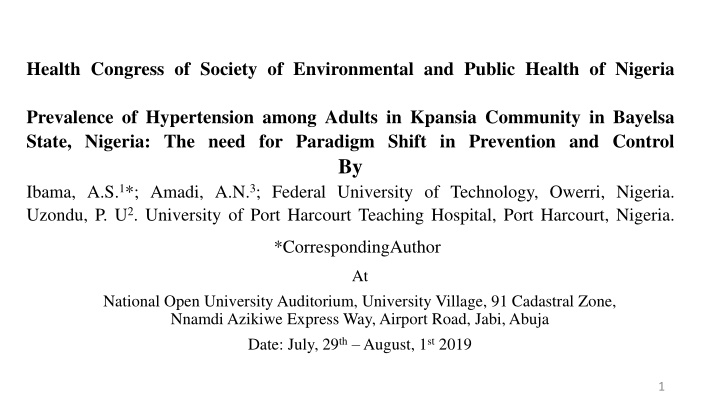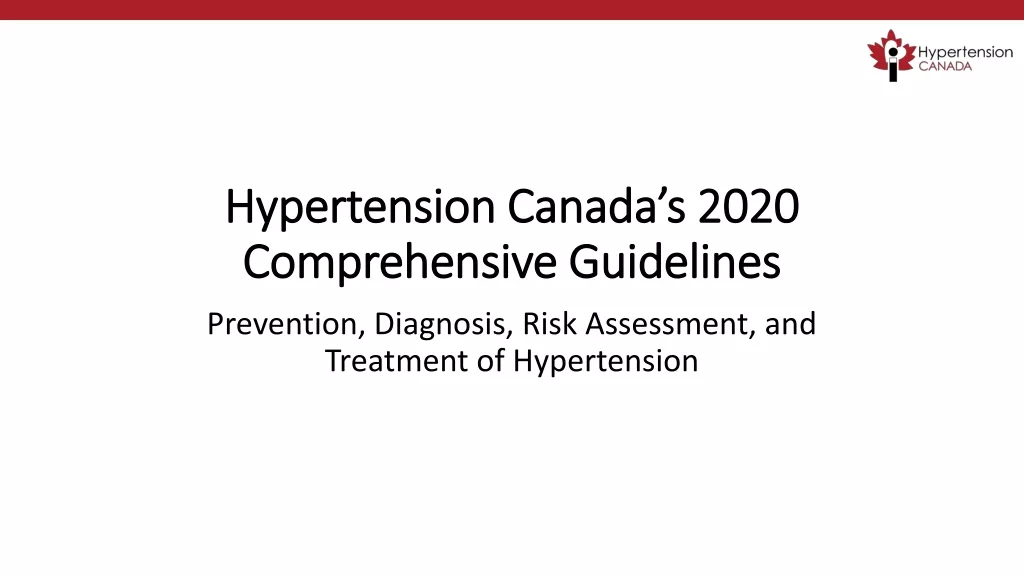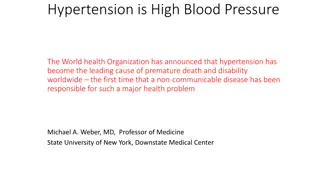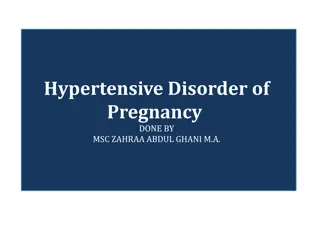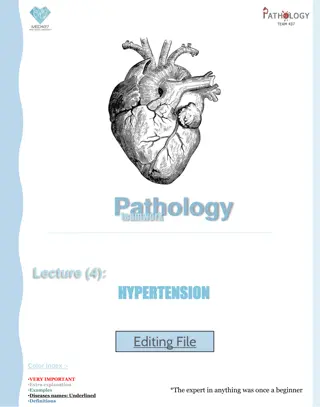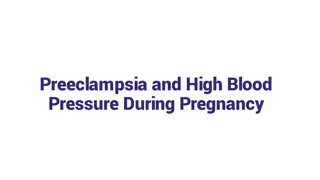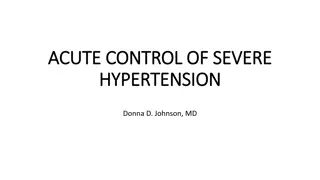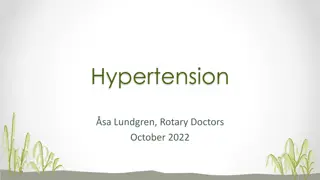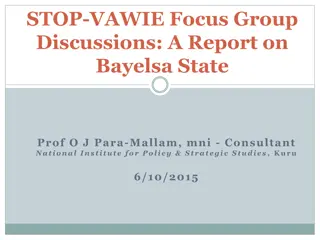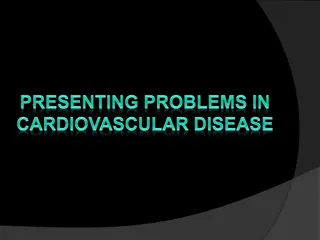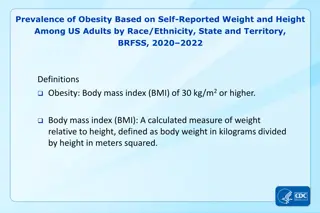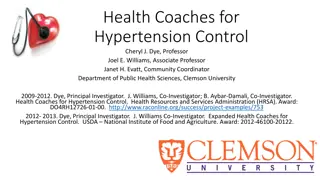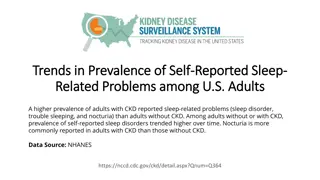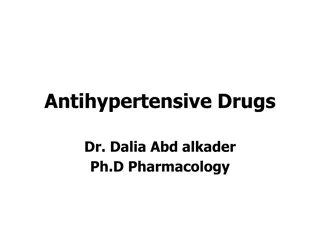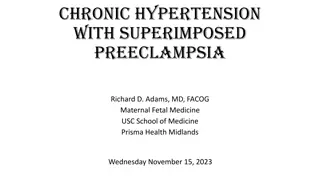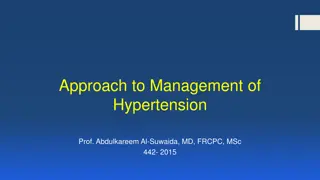Prevalence of Hypertension Among Adults in Kpansia Community, Bayelsa State: Paradigm Shift in Prevention and Control
This study explores the prevalence of hypertension in Kpansia Community, Bayelsa State, Nigeria, highlighting the need for a paradigm shift in prevention and control strategies. It aims to determine awareness levels and gender differentials in hypertension risk factors, emphasizing the importance of up-to-date information for effective resource allocation.
Download Presentation

Please find below an Image/Link to download the presentation.
The content on the website is provided AS IS for your information and personal use only. It may not be sold, licensed, or shared on other websites without obtaining consent from the author.If you encounter any issues during the download, it is possible that the publisher has removed the file from their server.
You are allowed to download the files provided on this website for personal or commercial use, subject to the condition that they are used lawfully. All files are the property of their respective owners.
The content on the website is provided AS IS for your information and personal use only. It may not be sold, licensed, or shared on other websites without obtaining consent from the author.
E N D
Presentation Transcript
Health Congress of Society of Environmental and Public Health of Nigeria Prevalence of Hypertension among Adults in Kpansia Community in Bayelsa State, Nigeria: The need for Paradigm Shift in Prevention and Control By Ibama, A.S.1*; Amadi, A.N.3; Federal University of Technology, Owerri, Nigeria. Uzondu, P. U2. University of Port Harcourt Teaching Hospital, Port Harcourt, Nigeria. *CorrespondingAuthor At National Open University Auditorium, University Village, 91 Cadastral Zone, Nnamdi Azikiwe Express Way, Airport Road, Jabi, Abuja Date: July, 29th August, 1st2019 1
Outline Background Problem Statement Aim of Study Objectives Materials and Methods Results Findings Conclusion Recommendations 2
Background Hypertension is a chronic non-communicable medical condition. It often leads to complication such as coronary heart disease, renal failure, peripheral vascular disease, retinal hemorrhage and visual impairment, amongst others. It is usually perceived to be more associated with urban/city lifestyle than rural living, but socio-demographic and socio-economic drivers of hypertension in the population are in recent instance generally impactful even in rural setting which can influence changing pattern of the disease. To reduce the burden in Nigeria at large, it is important to have detailed up to date information on the prevalence of hypertension in order to match this with available resources. 3
Problem Statement Hypertension affects over 1.3 billion people worldwide. It is the most common cardiovascular disease in black Africans and a major cause of morbidity and mortality among Nigerians. It leads to unacceptably high morbidity and mortality from potentially preventable complications such as coronary heart disease, heart failure, strokes and chronic renal failure. The reported prevalence of hypertension varies widely in the various parts of the world, as low as 3.4% in rural Indian men and as high as 72.5% in Polish women. In North America, two national surveys in the United States during the last two decades put the overall prevalence amongst American adults at 28%, while in Canada the prevalence is 27.4%. Data published from Nigeria, Ghana, Cameroon and The Gambia have shown a higher prevalence of hypertension generally and a consistently higher prevalence in urban than in rural areas. Little is known about the magnitude and determinants of hypertension in Yenagoa particularly in the study area (kpansia Community). 4
Aim of Study The study aimed to determine the prevalence of hypertension and level of awareness on risk of hypertension among adults with gender differential in Kpansia, Bayelsa State as a typical rural community in Nigeria. 5
Objectives To determine the prevalence of hypertension among adult living in kpansia community To determine if there is difference in prevalence of hypertension among male and female adults in Kpansia Community. To find out the level of awareness of risk factors associated with hypertension among adults living in Kpansia Community. 6
Materials and Methods A descriptive cross-sectional study design was used to study 230 adults aged between 18-59 years in Kpansia community who were selected through multi-stage simple random technique. Kpansia Community is one of the communities in Epie Kingdom of Yenagoa LGA and politically in ward 5 with 10 compounds (Asiou, Agalaba, Asuta, Ekien, Korangban, Otitigburu, Nesamba, Obigba, Enuomeni and Atolso) occupying a landscape of about 18 square/kilometers and located at latitude 4.9340 N - longitude 6.3129 E (GPS coordinates). The Community has a projected total population of 7,421in 2018 according to the National Population Commissions census in 2006 and 41.36% of this population is adult giving approximately 3,069 adults that forms the sampling frame from which the sample size was drawn. Blood pressure was measured using mercury sphygmomanometer and stethoscope held at the left arm of the respondents over the brachial artery in a sitting position and the stethoscope was placed over the brachial pulse (Ibama, 2011) in addition to self administered semi structured questionnaire on demographic characteristics and level of knowledge and awareness on risk factors of hypertension. The Inclusion criteria was Persons aged 18-59 years that are residing in Kpansia at the time of the study, whileExclusion criteria was Adults who have speech or hearing defects (deaf and dumb) and Mentally ill adults. Data was analyzed using SPSS version 23 and descriptive method used in presenting characteristics of respondents. 7
Results SOCIO-DEMOGRAPHIC CHARACTERISTICS OF RESPONDENTS Age (years) Frequency n=230 21 49 50 9 24 32 21 24 230 Percentage 18-22 23-27 28-32 33-37 38-42 43-47 48-52 53-59 Total 9.1 21.3 21.7 3.9 10.4 13.9 9.1 10.4 100.0 Sex (gender) MALE FEMALE Total Religion CHRISTAINITY ISLAM TRADITIONALIST Total Marital Status SINGLE MARRIED DIVORCED SEPERATED WIDOWED Total 106 124 230 46.1 53.9 100.0 210 12 8 230 91.3 5.2 3.5 100.0 91 114 8 10 7 230 39.6 49.6 3.5 4.3 3.0 100.0 8 Minimum age =18; maximum age = 59; mean = 34.91 standard deviation = 11.120
Results Contd SOCIO-ECONOMIC CHARACTERISTICS Educational level Frequency n=230 17 20 114 79 230 Percentage No formal education Primary education Secondary education Tertiary education Total Occupation EMPLOYED (FORMAL) EMPLOYED (SELF) RETIRED UNEMPLOYED SKILLED WORKER STUDENT Total 7.4 8.7 49.6 34.3 100.0 37 68 11 41 32 41 230 16.1 29.6 4.8 17.8 13.9 17.8 100.0 9
Results Contd OBJECTIVE 1 BLOOD PRESSURE STATUS OF THE STUDY POPULATION SYSTOLIC AND DIASTOLIC BLOOD PRESSURE OF STUDY POPULATION N Range Minimum Maximum Mean Systolic blood pressure (mmHg) Diastolic blood pressure (mmHg) Total 230 120 70 190 119.43 230 70 40 110 75.87 230 10
Results Contd SYSTOLIC BLOOD PRESSURE STATUS OF THE STUDY POPULATION IRRESPECTIVE OF GENDER (SEX) Systolic Blood pressure status ( 140mmHg) HYPERTENSIVE NON- HYPERTENSIVE Total Frequency n=230 43 Percentage % 18.7 187 81.3 230 100.0 11
Results Contd DIASTOLIC BLOOD PRESSURE STATUS OF THE STUDY POPULATION IRRESPECTIVE OF GENDER (SEX) Diastolic Blood pressure status ( 90mmHg) HYPERTENSIVE NON- HYPERTENSIVE Total Frequency n=230 Percentage % 59 171 25.7 74.3 230 100.0 12
Results Contd OBJECTIVE 2 BLOOD PRESSURE STATUS BY GENDER OF THE STUDY POPULATION SYSTOLIC BLOOD PRESSURE STATUS BY GENDER OF THE STUDY POPULATION Systolic (hypertensive) ( 140mmHg) Hypertensive Frequency Percentage Non-hypertensive Frequency Sex percentage Total frequency 106 Total Percentage 100 MALE FEMALE 23 21.7% 83 78.3% 20 16.1% 104 83.9% 124 100 Total 43 187 230 13
Results Contd DIASTOLIC BLOOD PRESSURE STATUS BY GENDER OF THE STUDY POPULATION Diastolic (hypertensive) ( 90mmHg) Hypertensive Frequency Percentage Non-hypertensive Frequency Sex percentage Total frequency 106 124 230 Total Percentage 100 100 MALE FEMALE Total 34 25 59 32.1% 20.2% 72 99 171 67.9% 79.8% 14
Results Contd STATISTICAL DIFFERENCE OF LEVEL OF PREVALENCE OF HYPERTENSION BY GENDER OF STUDY POPULATION Blood pressure Prevalence for males 21.7 Prevalence for Females 16.1 Statistical difference 5.6% Systolic blood pressure Diastolic blood pressure 32.1 20.2 11.9% 15
Results Contd OBJECTIVE HYPERTENSION LEVEL OF AWARENESS OF RISK FACTORS OF HYPERTENSION AMONG RESPONDENTS 3: AWARNESS OF THE RISK FACTORS OF Variable Have you heard of hypertension? Yes No TOTAL Where did you hear it from? Health campaign Health workers Media Frequency (n=230) Percentage (%) 195 35 230 84.8 15.2 100 52 29 31 22.6 12.6 13.5 Family 44 19.1 Neighbors 40 17.4 None TOTAL 35 230 15.2 100 16
Results Contd LEVEL OF AWARENESS OF RISK FACTORS OF HYPERTENSION AMONG RESPONDENTS Variable What are the symptoms of hypertension? Frequency (n=230) Percentage (%) Nervousness/anxiety Headache Dizziness Rapid heart rate Shortness of breath All of the above No visible symptoms I don't know TOTAL 40 14 11 25 18 66 6 50 230 17.4 6.1 4.8 10.9 7.8 28.7 2.6 21.7 100 17
Results Contd LEVEL OF AWARENESS OF RISK FACTORS OF HYPERTENSION AMONG RESPONDENTS Frequency (n=230) Variable Percentage (%) Can hypertension be inherited? Yes No 98 62 70 230 42.6 27.0 30.4 100 I don t Know Total Can smoking predispose to hypertension? Yes No 100 55 43.5 23.9 I don t know Total Can excessive alcohol intake predispose to hypertension? 75 230 32.6 100 No 113 49.1 Yes 72 31.3 45 230 19.6 100 I don t know TOTAL 18
Result Contd LEVEL OF AWARENESS OF RISK FACTORS OF HYPERTENSION AMONG RESPONDENTS Frequency (n=230) Variable Percentage (%) Can excessive salt intake predispose to hypertension? Yes No 112 48 70 230 48.7 20.9 30.4 100 I don t know Total Can lack of exercise predispose to hypertension? Yes No 124 42 64 230 53.9 18.3 27.8 100 I don t know Total 19
Findings The Prevalence of systolic and diastolic hypertension among adults was 18.7% and 25.7% respectively which is higher compared to the studies of Oduwole et al,(2012), in Lagos, Ismail et al, (2013) in Amassoma town (Bayelsa state) and Onwuchekwa et al, (2015) in Kegbara-Dere (Rivers State). The higher prevalence may be attributed to low level of awareness on risk factors of hypertension, noting that Kpansia Community is a rural settlement. Since most public health interventions on diseases of public health importance in which hypertension is implicated are concentrated in the urban/city communities/settings including Lagos, Amassoma, Kegbara-Dere etc. The systolic hypertension among males and females was 21.7% and 16.1% respectively (5.6% males disadvantage predisposition to systolic hypertension) and diastolic hypertension among males and females in the study population was 32.1% and 20.2% respectively (11.9% males disadvantage predisposition to diastolic hypertension), is much higher than that of Uwaezuoke et al, (2016) study in Enugu. The difference in prevalence of hypertension between males and females in this study may be explained in terms of male adults engaging in more at risk lifestyle to hypertension than their female counterparts making them predisposed to hypertension more than the female adults. The level of awareness on the risk factors was below 50% among the study population except the risk factor of physical inactivity (53.9%). This is in line with the studies of Ibrahim (2012) in Borno state, Olusoji et al, (2015) in Lagos state, Egbi, (2015) in Bayelsa state, but different from the results gotten by Abdulaziz et al,(2017) who recorded a high awareness (87.7%) of the risk factors of hypertension in Sokoto state. However, the difference in level of awareness on risk factors of hypertension may be explained in terms of poor awareness creation intervention programmes on hypertension despite its socio-demographic and socio-economic drivers that is generally impactful even in rural setting in Nigeria. 20
Conclusion The prevalence of systolic and diastolic hypertension is high among adults aged between 18-59 years whereas, the prevalence of hypertension is higher in males than females of the study population. Also, the level of awareness on the risk factors associated with hypertension is low among adult population. 21
Recommendations Paradigm shift towards rural community s focused preventive and control enlightenment campaigns on the risk factors of hypertension are necessary to tackle the burden of hypertension in our setting. Health education on importance of routine medical check-up, potential complications and risk factors associated with hypertension should be undertaken at every health facility providing primary care to enhance health seeking behaviour in the population. 22
